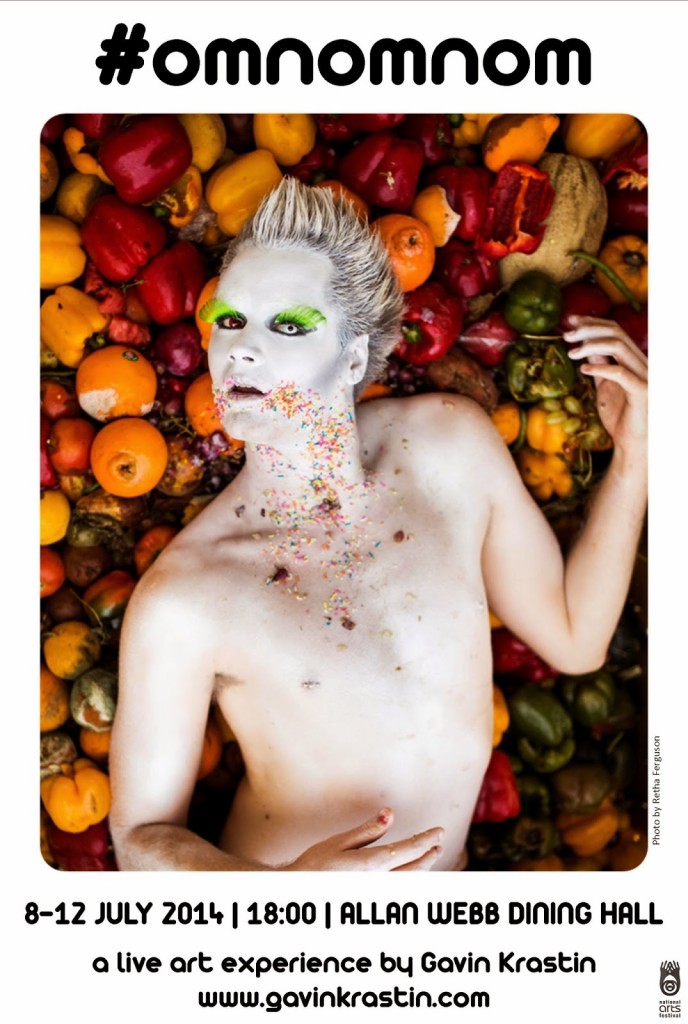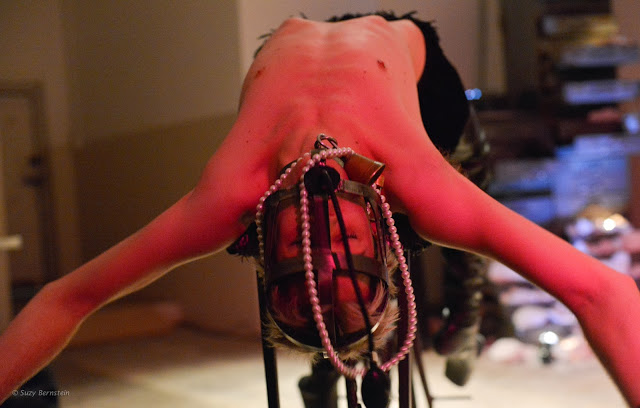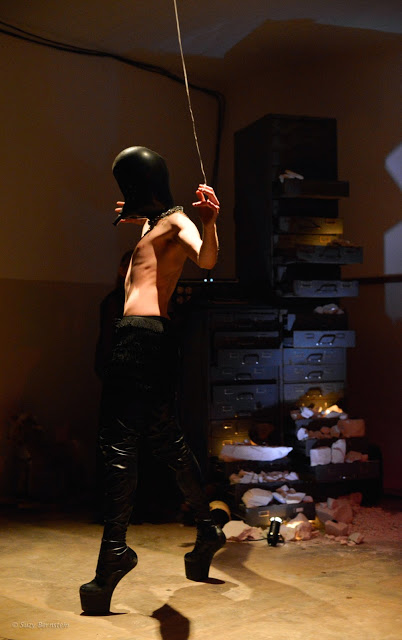Perspectives on Performance Art in South Africa
An Interview with Gavin Krastin
BY EMMALY WIEDERHOLT
Gavin Krastin is a South African performance artist and is presenting his newest work, #omnomnom, at the National Arts Festival.
Emmaly Wiederholt: Can you tell me about your piece, #omnomnom?
Gavin Krastin: Food is very symbolic. Where do we get our food from? How do people eat? What do they eat? What is considered good manners? I’ve taken various food rituals and splashed them together to make this fictitious ritual in which all these various cultural stances on food come forth. I’m drawing metaphors between body, food and landscape. The body is food is land. The way people engage with food is metaphorical to colonizing or exploiting land or the body.
You’ll see in this work I play with notions of the body as irreverently represented as a Christ-like figure, taking into account South Africa’s history of the myth of the white man providing. I often play with my gender a lot as well with presenting myself as this white Christ-like figure who also assumes this womanly role. I play with the roles of provider, consumer, architect and destroyer.
Politics come into the space as well. I’m performing in the Allan Web Dining Hall, which is one of the oldest places on Rhodes Campus. It was built by the nuns and it’s a place of white Christianity and white patriarchy, so how do I inject something completely other in that space as a means to critique the ideologies of that space.
EW: Where are you based?
GK: At the moment I’m going through an awkward transition phase in my life as most recent graduates do. I studied at Rhodes University for seven years, but I’m born and bred in Cape Town. Now I’ve gone back to Cape Town about two years ago and am slowly finding my feet doing various freelance projects. I’m also teaching part time at the University of Cape Town, teaching performance art in the drama department. I love working with youth; they’re so inspiring. There’s something so lovely about working with ignorance. They are so full of questions and haven’t been jaded yet, so I very much enjoy working with the students. They learn conventions in different classes and then they come to performance art where we un-train and deconstruct.
Gavin Krastin in Rough Muisck; photo by Suzy Bernstein
EW: Can you tell me a little about the culture of performance art in South Africa?
GK: It’s very small at the moment but it’s taking off and it is going to get better. A lot of academics and cultural analysts say we’re always working in response to the West. What I’m noticing is that we need more of a discourse, because performance art in African culture has been around since the dawn of mankind in terms of symbology, costume, ritual, the use of space, colour, symbol, dance, and gender politics. And yet the formalization of performance art in South Africa is through a Western channel. So now you’ve got a Westernized performance art, and then the performance art inherent in our culture and in everyday life. I think people are trying to navigate that.
Nobody learns performance art. You go to a music school, a journalism school, or a dance school and then you appropriate it and reconstruct it and revolt here and there. There’s quite an issue with regards to how those who are trained through visual art approach performance art as opposed to those who train through theatre. The performance art is more layered from those who have trained in theatre with symbols upon text upon space upon colour upon costuming upon lighting upon how the audience sits. I read things in which visual artists write about performance art as if it’s quite novel. Visual arts make non-time based objects, so suddenly the idea of an ephemeral time-based medium is new.
I don’t think it has to be an issue. There’s enough space under the sun for both of us. The galleries in South Africa are more willing to put on performance art than the theatres, so there’s quite a ramification around that as well regarding who gets seen or not. South African performance artists need to band together. Performance art was huge during the resistance time in South Africa and people inherently performed their displeasure with Apartheid in the form of protests and interventions. And now there’s an attitude of, “We’ve done that so let’s rest on our conceptual laurels.” With this whole urban-hipsterization of everything, everything is clean, sanitized and highly cerebral. I think we need to go back to the experiential. The momentum is there, but give us some time. There’s only so much money and time and space.
EW: Do you do your art on your own dollar?
GK: I am the worst businessman in that all I care about is my audience. If I run at a loss, it’s okay as long as they had an awesome time. My work is quite intimate. I can never cover costs because I will never perform to more than 50 people at one time. A few people stand around and engage with me on a very intimate level as opposed to 2,000 people. I bank on commissions and funding, but it is my passion so I make sacrifices.
Performance art is still looked at as visual art and theatre’s ugly stepsister. Let’s find this ugly stepsister her own bedroom. But at the same time South Africans are so impatient: Apartheid fell, where’s the change? Performance art has been on the Main Festival for two years, why isn’t it enormous? There’s a lot of impatience. It’s happening but we’re all working hard and wearing so many hats teaching, producing, designing, lecturing, writing. But it’s happening. There’s a whole new generation coming in to whom Apartheid is understood through stories and videos. I didn’t experience Apartheid on a spiritual and emotional level because I was too young. But the trend has been toward conceptual work. I think in South Africa we are on the precipice of performance artists and con artists. There’s a lot of bullshit under the guise of art. If you can conceptually and academically argue for your work it’s okay. But at the end of the day people forget what the role of the audience is. I don’t care how much you can conceptualize something, if your audience has not had a visceral response, if something in their soul and brain has not been stirred, if all they are watching is a glorious act of repetition with no substance, as much as you shroud that in theory and concept, what is the point? What is the role of audience? I myself have tried to get rid of the notion of audience and rather look at them in the role of co-producers. So much of performance art is immersive and interactive; they really are a seminal aspect of the creation.
Gavin Krastin in Rough Muisck; photo by Suzy Bernstein
Learn more about Gavin at www.gavinkrastin.com.



